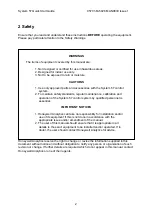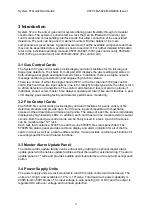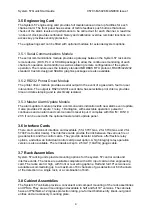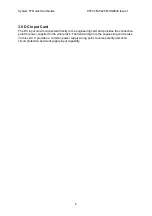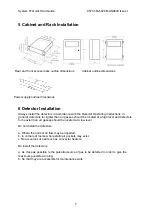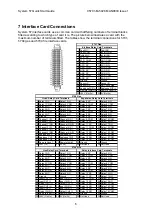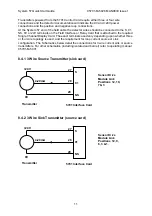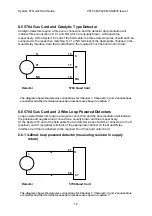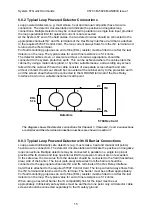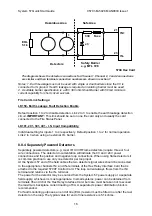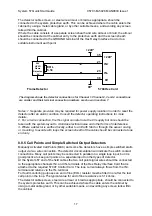
System 57 Quick Start Guide
05701-M-5026 MAN0839 Issue 1
8.8.2 Typical Loop Powered Detector Connections
Loop powered detectors (e.g. most smoke, heat and manual call points) have two wire
connection. The detector documentation will indicate the positive and negative loop
connections. Multiple detectors may be connected in parallel on a single loop input provided
the loop operational limit for quiescent current is not exceeded.
At the System 57 end of the field cables, the two detector wires should be connected to the
appropriate channels IN+ and IN- terminals of the Hex Relay Interface Card that is attached
to the required 5704F Control Card. The loop current always flows from the IN+ terminal and
returns via the IN- terminal.
For fault monitoring purposes an end of line (EOL) resistor must be fitted in or after the last
detector on the loop. The typical value for end of line resistance is 5.1k ohms.
The detector cable screen, or steel wire armour or braid as appropriate, should be
connected to the system protective earth. This can be achieved where the cable enters the
cabinet by using a metal cable gland, or by other suitable means, and avoiding any screen
tails within the cabinet. Where the cable consists of a separate screen sheath and wire
armour or braid, the armour should be connected at the cabinet entry to the protective earth
and the screen sheath should be connected to the GROUND terminal of the Hex Relay
Interface Card or to a suitable instrument earth point.
EOL
5.1k
-
+
IN-
-
+
23
21
Detectors
IN+
5704 Hex Card
The diagram shows the detector connections for Channel 1. Channel 2, 3 and 4 connections
are similar and their terminal connection numbers are shown in section 7.
8.8.3 Typical Loop Powered Detector with IS Barrier Connections
Loop powered intrinsically safe detectors (e.g. most smoke, heat and manual call points)
have two wire connection. The detector documentation will indicate the positive and negative
loop connections. Multiple detectors may be connected in parallel on a single loop input
provided the IS criteria and loop operational limit for quiescent current are not exceeded.
In the safe area, the two wires from the detector should be connected to the field (hazardous
area) side of the barrier. The input (safe area) side wires from the barrier should be
connected to the appropriate channels IN+ and IN- terminals of the Hex Relay Interface
Card that is attached to the required 5704F Control Card. The loop current always flows from
the IN+ terminal and returns via the IN- terminal. The barrier must be earthed appropriately.
For fault monitoring purposes an end of line (EOL) resistor must be fitted in or after the last
detector on the loop. The typical value for end of line resistance is 5.1k ohms.
When using an external barrier the IS compatibility link for the input must be set
appropriately. Intrinsically safe systems must be earthed at one point only. All detector cable
screens should be connected separately to the IS safety ground.
15


